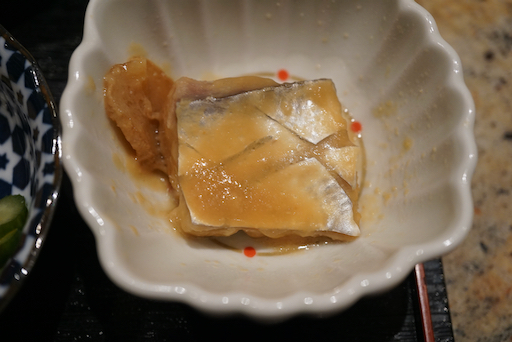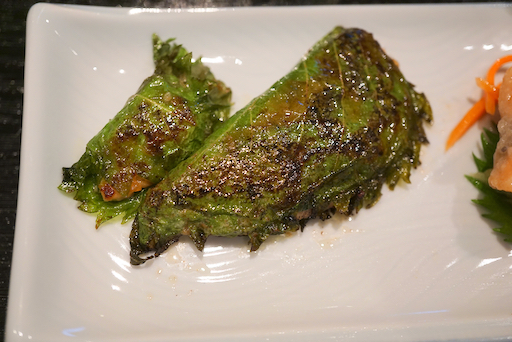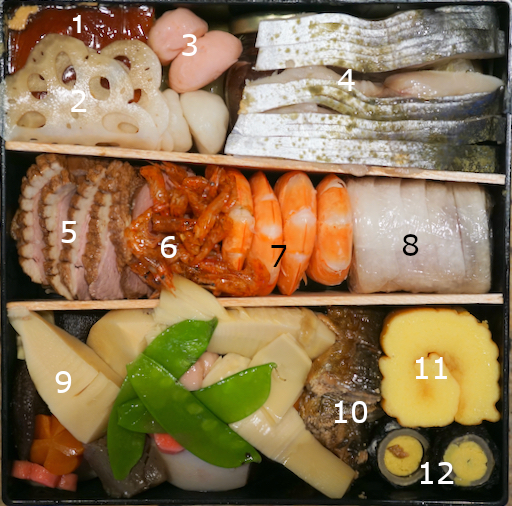Grilling: I used a Weber grill with lump charcoal. As usual, I started the fire using a Charcoal starter chimney. I spread hot coals over only half of the grill to make hot and cool areas. After cleaning the grill, I sprayed Weber-brand grilling spray (this does not flare up even with hot coals underneath). I started the meat side down on the hot area of the grill for 2 minutes or so and flipped it over to grill the skin side for one to two more minutes. Because of the sugar content of the miso marinade, it is very easy to char the fish like I did here (image below right, but it still tasted good). I moved the fillet to the cool side of the grill and put the lid on and finished cooking for 2-3 more minutes.
Sunday, June 12, 2011
Miso grilled Spanish mackerel サバの味噌焼き
Grilling: I used a Weber grill with lump charcoal. As usual, I started the fire using a Charcoal starter chimney. I spread hot coals over only half of the grill to make hot and cool areas. After cleaning the grill, I sprayed Weber-brand grilling spray (this does not flare up even with hot coals underneath). I started the meat side down on the hot area of the grill for 2 minutes or so and flipped it over to grill the skin side for one to two more minutes. Because of the sugar content of the miso marinade, it is very easy to char the fish like I did here (image below right, but it still tasted good). I moved the fillet to the cool side of the grill and put the lid on and finished cooking for 2-3 more minutes.
Saturday, July 23, 2016
Canned Mackerel canapé サバのアメリカ版缶詰のカナッペ
Monday, September 7, 2020
Cabbage and perilla in brine キャベツの青じそ漬け
4-5 Green perilla leaves, cut into 1cm square
1/2 cup hot water
1 tsp salt
1/2 tsp sugar
1/2 tsp rice vinegar
In a Ziploc bag, add the cabbage and green perilla, pour in the brine, remove the air as much as you can and seal. Sandwich the bag between two plates and put the weight and let it stand for 30 minutes until more water comes out and the cabbage becomes soft. It will keep several days in the refrigerator.
The brine was rather gentle and the cabbage tasted fresh and had a nice crunch. eating it with the perilla pieces really made it. This is a nice refreshing dish.
Thursday, July 26, 2018
Perilla tea and perilla rice 大葉茶と大葉ご飯
I further fortified the perilla flavor by adding a chiffonade of green perilla and store bought "Yukari" ゆかりsalt which is made of dried red perilla and salt.
This time, I used match sticks of daikon and carrot in the mackerel dumpling soup.
The miso simmered mackerel is our favorite dish.
Ingredients for perilla tea:
20 green perilla leaves, washed and torn (amount appears to be arbitrary)
1/2 tsp salt
8 cups water
Add hand torn perilla leaves and salt to the water when it starts boiling then turn down to simmer and cook for 15-20 minutes. I let it steep until cooled to room temperature and remove the perilla leaves.
Although I did not take pictures, the resulting "tea" has a slight brown color with a strong perilla smell. We just used the perilla tea instead of water in our rice cooker to make the perilla rice. When the rice was done, it definitely smelled like perilla although the taste did not come through. By adding a chiffonade of fresh perilla leaves and "Yukari", this was a quite pleasant seasoned rice. Of course, my wife added a pat of butter to her rice to make it "better"(or maybe "butter").
Wednesday, June 9, 2021
Bluefish "sanga" fish cake ブルーフィシュのサンガ
Blue fish meat scraped off the bone, tail and other parts, hand chopped using a heavy Chef’s knife, about 150grams (a guess)
Red miso 1 tbs
Ginger cut finely, 1 tsp plus ginger juice from grated ginger (about 1/2 tsp)
Scallion, 4 stalks, finely chopped
Potato starch (katakuri-ko) 2 tsp
Dark sesame oil 1/2 tsp
Perilla leaves (4-6 depending on the size)
Directions:
Mix all ingredients well except for the perilla leaves.
Divide the mixture into 6 equal portions.
Lightly oil hands and make the portions into flat discs and place the perilla leaves on one side (#1) in the third picture).
On a medium low flame with a small amount of neutral oil, first cook the side without perilla leaves until nicely browned (#2).
Flip it over and cook the other side for another 1 minute or so or until done (#3 and #4).
This is a good way to use scrap fish meat from the bluefish. The double doses of ginger juice and finely chopped ginger add ginger flavor but not overwhelmingly so. The miso flavor and sesame oil are a good combination. I am not sure if I can taste the perilla leaves. It warmed up nicely by microwaving.
Friday, October 30, 2020
Grilled bluefish and matsutake lunch
We used to get a whole fresh Spanish mackerel at Whole foods, but it has not been available for a long time. Since we started buying groceries from the Korean grocery store HMart through Instacart, we have found they have more variety of whole fresh fish available. We got whole Spanish mackerel from them a few times. This time, however, mackerel was not available but bluefish was. We have used bluefish* in place of Spanish mackerel in the past and decided to go with it. I am not sure how I ordered it (by weight or by the numbers) but I ended up with two rather large bluefish not cleaned at all. So, I had to scale, gut, remove head and make filets. It was a bit of work but the fish was really fresh. As before, I made bluefish simmered in miso sauce ブルーフィシュの味噌煮 from the filets and "tsumire" fish balls soup つみれ汁 from the fish meat scraped off the bones. I set the fish ball soup and miso simmered fish aside for another meal. The remaining filets, I salted and grilled. We happened to have matsutake 松茸 from Oregon mushroom and matsutake rice 松茸ご飯 rice leftover from dinner the previous night. So I made matsutake soup 松茸のお吸い物, warmed up the rice and served with the bluefish for our lunch on Sunday.
* I am not sure of its Japanese name but it appears to be "Oki-suzuki" オキスズキ. I have not seen or eaten it while I lived in Japan.
I first salted the fillet and let it sit in the refrigerator for a few hours. I cooked the bluefish filet with a small amount of olive oil in a frying pan on low flame with skin side down until the skin got brown (6-7 minutes, I also applied decorative cuts on the skin to prevent the skin breaking during the cooking). I cooked 80% on the skin side, flipped it and completed the cooking. I served this with pickled myoga 冥加の甘酢漬け, salt picked cucumber and nappa cabbage きゅうりと白菜の浅漬け and thinly sliced cucumber dressed in sushi vinegar 胡瓜の酢の物. Since the fish was well-salted, we did not need additional sauce such as soy sauce for this.
For the matsutake soup 松茸のお吸い物, I made bonito "dashi" カツオの出汁 from a dash pack seasoned with mirin and light colored soy sauce and salt, added thinly sliced matsutake, silken tofu, "kyoubu" 京麩 decorative gluten cake (dried, hydrate before adding to the soup), freeze dried "mitsuba" 三つ葉 and yuzu zest ゆず (frozen).
The bluefish prepared this way was very good. The flesh was pleasingly oily, soft and had a nice flavor. The skin did not get crispy but stayed soft. It may have been a bit strong tasting fish to accompany the delicate matsutake but we really enjoyed this lunch.
Monday, September 28, 2020
Salted and grilled mackerel 鯖の塩焼き
Come to think of it, I never cooked mackerel this basic way. When I got two whole Spanish mackerels from HMart via Instacart, there was too much to make it all into the miso-simmered dish 鯖の味噌煮 I usually make. So, I took two filets I prepared from the smaller of the two fish and made this salted and grilled mackerel. I filleted the fish and removed the small pin bones. Then I cut one filet into two and salted both sides. I let it stand for 10 minutes and blotted the surfaces using a paper towel. I made shallow cuts on the skin and re-salted it. Since I do not have a Japanese style fish grill and I did not want to cook fish in the toaster oven, I sautéed the fillets in a frying pan with a small amount of olive oil.
This is a basic simple way of cooking mackerel but it was good. On the side, I added sliced mini-cucumber (salted and moisture squeezed out) dressed in sushi vinegar. Since we had just harvested and pickled myoga, I added it too. This could have gone very well with rice. We had it as a drinking snack with cold sake.
Thursday, February 6, 2020
"Shime saba" cured Norwegian mackerel しめ鯖
To prepare a frozen package of shime-saba as sashimi, first thaw it in the refrigerator in the package (I usually leave it overnight), remove it from the package, rinse and blot it with a paper towel and cover it with a sake-soaked paper towel for 5-10 minutes (I do this in the hope of reducing any excess fishiness that may be present). This fish does not have any scales but has a thin semi-tranparent skin which needs to be peeled off starting from the head side's edge. Although not really needed but I added several parallel shallow cuts along the length of the filet and then cut crosswise as seen below.
Soy sauce, grated ginger and scallion all work well with this fish and of course, the only drink that goes with this fish is sake. This was the very first dish of the evening and we enjoyed it.
Saturday, October 10, 2020
Grilled mackerel salad with “Yuzu” mayonnaise 柚子マヨあえ焼き鯖のサラダ
This is a small salad made of leftover salted and grilled mackerel 鯖の塩焼き. I just came up with this and did not have any recipe.
Saturday, December 19, 2020
Appetizers 4 kinds お通し4種類
Ingredients:
3 Japanese eggplant
2 tbs neutral vegetable oil
two small pieces of ginger, crushed with the side of the knife.
250ml Japanese dashi broth (I made this with my usual bonito and kelp dashi pack)
3 tbs soy sauce
3 tbs mirin
(Instead of soy sauce, I am using "shirodashi" 白だしand light colored soy sauce).
Directions:
Cut the eggplants in half lengthwise. Shallowly cut the skin in crosshatching pattern and then cut lengthwise again to make 1/4 eggplant.
Add the oil to a frying pan on medium flame and add the ginger for a few minutes until fragrant.
Add the eggplants skin-side down and fry for 3-4 minutes and turn over to fry both of the fresh sides for 2-3 minutes each,
Add the seasonings and broth (below), put on the lid and simmer for 3-4 minutes.
This is good eaten hot right after it is cooked but it can also be stored in the broth in a sealable container in the refrigerator. The stored eggplant can be eaten cold or heated up in the microwave.
This is usual salmon nanban. This one was really good since the quality of the salmon (from Whole foods) was good and I did not over cook it. I served this with sugar snap in salt broth スナップ豌豆の塩びたし.
Mr. and Mrs. Segawa of Tako Grill kindly gave us "kazunoko" herring roe 数の子. I prepared it as I described in my New Year dish tab. The half serving shown below was soaked in dashi broth with soy sauce and mirin seasoning. I marinated the other half serving in sake-lee and miso mixture or "kasu-miso" 粕味噌. Since this preparation will last longer than the one soaked in dashi broth we will eat it closer to the holidays.
I also served Spanish mackerel in miso sauce 鯖の味噌煮. (The red dots surrounding the mackerel are part to the decoration of the bowel not part of the preparation.)
This was a quite a good starter line up for the evening.
Monday, September 28, 2015
Vinegard sanma sashimi 〆さんま
I served it with two kinds of cucumber salad (one with thinly sliced myoga and one with thinly sliced red onion, both salted, washed and then excess moisture wrung out and dressed in vinegar dressing). I also put both grated ginger and wasabi.
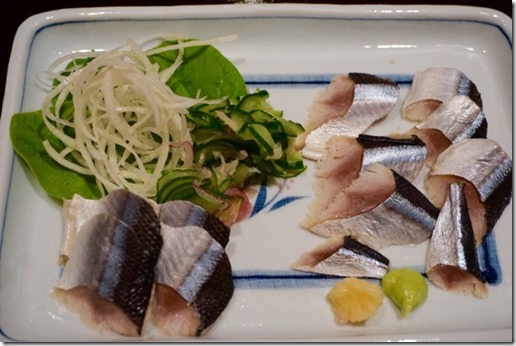
As you can see below, this is very well vinegared and the meat is all opaque (i.e. chemically cooked) which is the same in packaged frozen vinegared Mackerel.
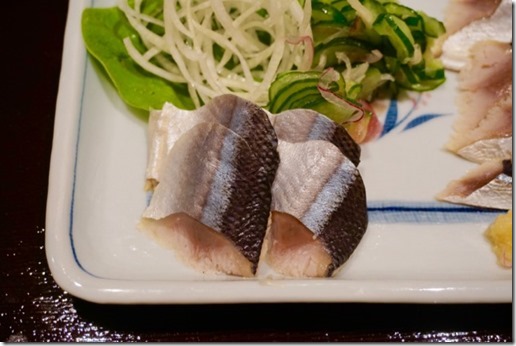
The below was how it came. One package had three filets of sanma.

After thawing, I blotted excess moisture and sliced it slightly obliquely.

 The shime sanma tasted very similar to shime saba or mackerel. The vinegar was a bit sweeter than I would like but my wife thought it was fine. As I mentioned, the meat was throughly vinegared and opaque. If the center was a bit closer to raw would have been better but I am asking too much.
The shime sanma tasted very similar to shime saba or mackerel. The vinegar was a bit sweeter than I would like but my wife thought it was fine. As I mentioned, the meat was throughly vinegared and opaque. If the center was a bit closer to raw would have been better but I am asking too much.The only drink that goes with this is sake. This sake called "Tozai Living Jewel" is widely available in US and appears to be an export only brand from Kizakura brewery 黄桜酒造 in Kyoto, Japan. We have tasted turbid sake from them before called “snow maiden” “Tozai Yuki musume” 東西雪娘.
The current one is "junmai shu" 純米酒 and it is not too yeasty, Although it does not have depth or complex flavors or fruity note (which is more from ginjo and daiginjo flavors) and the taste disappears quickly in the palate (i.e. short finish), it is quite a drinkable sake. This one went particularly well with a strong oily fish with vinegar and sweet taste of vinegared sanma we were having.
So, we enjoyed this dish and sake.
Saturday, July 25, 2020
Horse mackerel wrapped in perilla leaves 鯵の大葉バター焼き
4 raw jack mackerel or "aji" filets (thawed if frozen)
1 tbs miso
1 scallion, finely chopped
1/2 ginger, finely chopped
1/4 tsp soy sauce (optional)
1/4 tsp sugar
10 perilla leaves, washed and dried with stem end removed
Butter for frying
Directions
I first made "namerou" by chopping and pounding the aji with a sharp knife until the aji became a bit pastey. I mixed in the scallion, ginger, miso and sugar and kept pounding until well mixed. You could add a bit of soy sauce to adjust the seasoning and consistency. I placed a small amount of namerou on a perilla leave and folded it into half-moon shape (below)
Saturday, November 23, 2019
Baked tofu namerou 豆腐のなめろう
This "namerou" is, as I said, actually baked. The original recipe just said "spread on aluminum foil and bake". I thought it would stick to the foil, so I put it on parchment paper which turned out to be a wise move. I was able to remove it from the pan just by using the edges of the paper to lift it. I cut it into the two portions, still on the paper, as seen below. (The edges of the parchment paper are just visible.)
With this, I served my ususal mackerel simmered in miso. I also served marinated spicy tofu.
This recipe came from an Izakaya cookbook I recently acquired. The book has mostly standard Izakaya recipes but there are some interesting and unique dishes. I will make some more dishes and will include the description of this cookbook the Izakaya cookbook section of this blog. Again, I changed the amounts and made some modification since I did not have myouga)
Ingredients: (For two small servings, the original recipe used a 12 oz block of tofu, and myouga. I didn't have myouga or any thing I thought I could use as a substitute. I added Italian parsley)
Silken tofu 5oz (140g)(#1) To remove excess moisture I wrapped it in a paper towel and put it between 2 cutting boards to weight it down. The upper cutting board was heavy and wooden. I left it that way for 1 hour (#2).
Ginger root, grated (or from tube) 1/4 tsp
One egg yolk (#3)
1 tbs miso (#3)
1/2 tsp soy sauce (#3)
1 spring onion, finely chopped
1 sprig Italian parsley, stem removed and finely chopped (optional, if available use myouga)
Direction:
Using a knife, I chopped and mixed all ingredients (#4).
Spread thinly on parchment paper (this was my addition, without it the namerou would most likely stick to the aluminum foil) on aluminum foil covered baking sheet.
Bake at 400F for 10 minutes (#5, I used my toaster oven on convection mode).
Lift the baked namerou using two ends of the parchment paper, cut into two squares and serve hot with the parchment paper still attached (#6)
This is indeed a very unique and interesting dish. I could have seasoned it a bit more aggressively (more miso) and a hint of sweetness (maybe mirin instead of soy sauce) may have worked better. This is not like "nameous" made from raw fish like mackerel but still, a quite good small dish that goes well with sake.
Monday, January 4, 2021
Sushi Taro Osechi 2021 寿司太郎の御節 2021
Everything was carefully prepared and packed. All possible superlative adjectives can not begin to describe how wonderful each dish was. I do not know how many orders they prepare but I got some glimpse of how much work this is from Chef Kitayama's instagram "chefmasayakitayama" and "togimax". Our only task now is to enjoy all these delicacies, something we are very good at.































